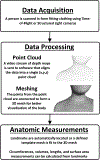Digital anthropometry: a critical review
- PMID: 29748657
- PMCID: PMC6411053
- DOI: 10.1038/s41430-018-0145-7
Digital anthropometry: a critical review
Abstract
Anthropometry, Greek for human measurement, is a tool widely used across many scientific disciplines. Clinical nutrition applications include phenotyping subjects across the lifespan for assessing growth, body composition, response to treatments, and predicting health risks. The simple anthropometric tools such as flexible measuring tapes and calipers are now being supplanted by rapidly developing digital technology devices. These systems take many forms, but excitement today surrounds the introduction of relatively low cost three-dimensional optical imaging methods that can be used in research, clinical, and even home settings. This review examines this transformative technology, providing an overview of device operational details, early validation studies, and potential applications. Digital anthropometry is rapidly transforming dormant and static areas of clinical nutrition science with many new applications and research opportunities.
Conflict of interest statement
CONFLICTS OF INTEREST
The authors declare no conflict of interest.
Figures



References
-
- West GM. Loughborough Anthropometric Shadow Scanner (LASS) Master of Philosophy, Loughborough University, Leicestershire, UK, 1987.
-
- Jones PR, West GM, Harris DH, Read JB. The Loughborough anthropometric shadow scanner (LASS). Endeavour 1989; 13(4): 162–168. - PubMed
-
- Jones PRM, Rioux M. Three-dimensional surface anthropometry: Applications to the human body. Opt Laser Eng 1997; 28(2): 89–117.
-
- Lerch T, MacGillivray M, Domina T. 3D Laser Scanning: A Model of Multidisciplinary Research. Journal of Textile and Apparel, Technology and Management 2007; 5(4): 1–22.
-
- Scharstein D, Szeliski R. High-accuracy stereo depth maps using structured light. 2003 IEEE Computer Society Conference on Computer Vision and Pattern Recognition, 2003.
Publication types
MeSH terms
Grants and funding
LinkOut - more resources
Full Text Sources
Other Literature Sources

